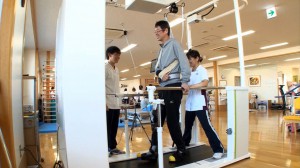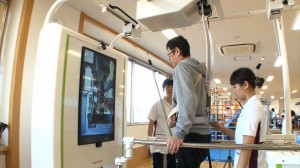
Toyota's Welwalk WW-1000 uses a robotic leg brace to help partial paralysis sufferers with their rehabilitation.
Toyota’s latest model introduction doesn’t shatter any speed records, offer industry leading fuel economy or come some unique color with “pearlescent” in the name — it is a wearable robotic leg brace that helps partially paralyzed people walk.
The device is named the Welwalk WW-1000. It’s composed of a motorized robotic frame that a person wears from the knee down. It’s used in concert with a specialized treadmill that can support the weight of the rehabbing patient. The system can be controlled by medical staffers using a touch screen.
The automaker worked with Fujita Health University to develop the device, which is designed to be worn on one leg at a time. Its focus is on improving mobility for a person who suffers from paralysis on one side due to a stroke or other similar issue.
Toyota put the new device on display at its headquarters earlier this week.
(Toyota brings future to the present with Kirobo Mini. Click Here for the story.)
The Welwalk WW-1000 comes with a range of rehabilitation support functions based on motor learning theory, Toyota noted. They include the ability to adjust the difficulty level to suit the patient, and to provide feedback about the patient’s gait characteristics. The robot’s simple construction and functions, such as easy fitting and central touch panel operation, ensure the ease of use in clinical settings.
Right now the primary users of the system would likely be stroke victims who are in recovery. As Japan’s population continues to age, Toyota’s device could be very helpful, said Eiichi Saito, a medical doctor and executive vice president at Fujita, to The Associated Press.
“This helps just barely enough,” said Saito, explaining that helping too much can slow progress in rehabilitation.
(Click Here to get details about Toyota’s Human Service Robot.)
He added that patients using it can recover more quickly as the sensitive robotic sensor in Welwalk fine-tunes the level of support better than a human therapist can. However, like many forms of technology, the early adopters will need to pay big money.
One hundred such systems will be rented to medical facilities in Japan later this year, Toyota revealed. The service entails a one-time initial charge of 1 million yen ($9,000) and a 350,000 yen ($3,200) monthly fee.
Toyota is not new to robotics. Aside from the simple robots the maker uses to help assemble vehicles around the globe, the company’s developed a variety of robots for other medical uses. Toyota’s Human Support Robot, which looks an awful lot like R2-D2 from the Star Wars films, uses a mechanical arm can help bed-ridden people pick up things.
(To see more about Toyota’s robotic collaboration with MIT, Stanford, Click Here.)
The company also has robots that can play the violin and trumpet and will begin selling a small boy-sized robot in Japan capable of holding conversations with people later this year. In fact, people-like robots built by a variety of automakers can do everything from kick a soccer ball to ride a motorcycle.

